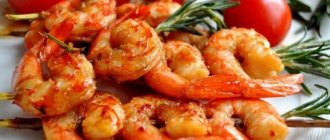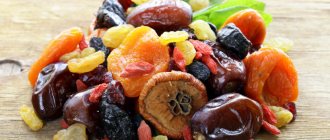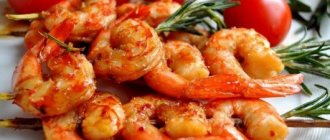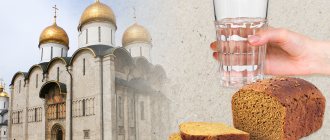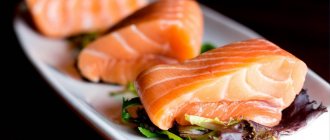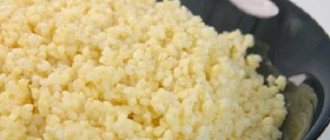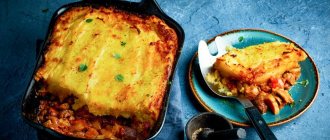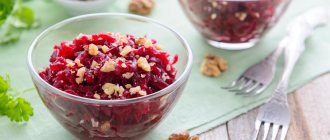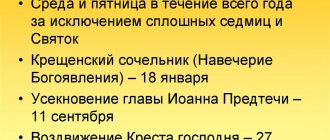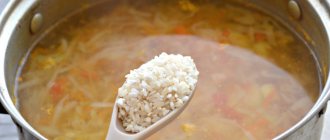"Save me, God!".
Thank you for visiting our website, before you start studying the information, please subscribe to our Orthodox community on Instagram, Lord, Save and Preserve † - https://www.instagram.com/spasi.gospodi/. The community has more than 60,000 subscribers. There are many of us like-minded people and we are growing quickly, we post prayers, sayings of saints, prayer requests, and timely post useful information about holidays and Orthodox events... Subscribe. Guardian Angel to you!
The church calendar includes a large number of holidays, Christmastide, and fasts. There are posts with different meanings. But there are also days during which food can be severely limited. Such days are called days of dry eating.
Dry eating: what can you eat? During this period, it is allowed to eat all foods without heat treatment. Fasting is not advisable, because it can harm the body.
Ingredients:
- Small pumpkin – 1 piece
- Honey or sugar - to taste
- Nuts or sesame seeds - to taste
[ads-pc-3]
Cooking
Take a sweet pumpkin, clean it, cut it into large pieces and place it on a baking sheet lined with parchment. Heat the oven to 213-250°. Bake the pumpkin for an hour. You can also determine the degree of its readiness by its intense smell. Remove the pumpkin from the oven, pour honey or sprinkle with sugar, and decorate with nuts or sesame seeds.
Why do you need dry eating?
You can free your soul from anger, gossip, resentment and unforgiveness and receive healing through prayer with humility. Only after clearly understanding the meaning of the post can you enter into it.
Read about the post:
- What is fasting in Orthodoxy
- Petrov post
- How to fast on Wednesday and Friday
For the laity, TV and computers become an addiction. The time of abstinence should begin with increased time of prayer and study of the Word of God in order to fill the soul with spiritual things and cleanse oneself from the passions of this world, while limiting the viewing of TV series.
Eating food without heat treatment is called dry eating.
Few lay people know that this term means the degree of strict fasting; it is described by the monastic Rules. Ordinary laymen must take the blessing of their confessor for fasting.
Important! Complete abstinence from processed foods is recommended by the church on Mondays, Wednesdays and Fridays during the entire abstinence period. Lent begins and ends with a week of dry eating.
Relaxation is made for children, pregnant women, and the sick. Those suffering from severe types of diabetes, tuberculosis, dystonia, and anemia can receive relief from their confessor for fasting.
When refusing basic, familiar food, the following foods are not included in the diet:
- dairy products;
- meat;
- salo;
- offal;
- vegetable oils;
- wine;
- fats.
It is prohibited to heat treat all foods, including vegetables, fruits, and prepare hot drinks, but it is allowed to eat bread.
Ingredients:
- Cabbage – 1 head
- Onion - 1 pc.
- Walnuts – 1 handful
- Cilantro – 1 bunch
- Saffron - to taste
- Apple cider vinegar - to taste
- Salt - to taste
[ads-pc-3]
Cooking
We cut a small head of cabbage into two parts, remove the stalk and finely chop it.
Place it in a large saucepan, add salt and cover with a lid for 20 minutes. During this time, the cabbage will give juice. Then we rub it with our hands, squeezing out the excess juice. Add finely chopped onion, crushed walnuts, finely chopped cilantro to the cabbage, add salt. Add saffron. Season with apple cider vinegar.
Mix everything well and put it in a salad bowl.
Recipe Tip: You can substitute roasted cashews for the walnuts. Very tasty too!
A lighter version of the “dry” fast
When using a lighter version, you can add vegetables and fruits baked in the oven or oven to the permitted products. You can drink tea and coffee. Add baked potatoes without adding oil to the menu. You can prepare pumpkin porridge with honey in water, as well as porridge from bags, when to prepare it you just need to pour boiling water over it.
Ingredients:
- Marinated artichokes – 80 g
- Grapefruit – 80 g
- Leaf lettuce – 30 g
- Grated almonds – 10 g
[ads-pc-3]
For the sauce:
- Lemon juice – 1.5 tbsp. l.
- Honey – 1 tsp.
- Grapefruit juice – 2.5 tsp.
- Salt - to taste
- Pepper - to taste
[ads-pc-3]
Cooking
- Remove the prepared marinated artichokes from the jar and bake them in the oven for ten minutes. When the artichokes are slightly charred, remove the burnt “skin” from them, cool and cut each into four parts. Next, remove the zest, inner skin and seeds from the grapefruit. Cut each slice with a sharp knife to make 3-4 thin segments. Wash, dry and tear lettuce leaves (lollo rossa, frise, etc.) into pieces with your hands.
- Prepare the sauce by mixing lemon and grapefruit juice, liquid honey, salt and pepper. You should get a sweet and sour dressing.
- Mix all the salad ingredients, sprinkle with grated almonds and pour over the prepared sauce.
Salad secrets:
1. Artichokes are the fleshy, unopened flowers of the Cynara Scolymus plant, widespread in the Mediterranean countries and the Canary Islands. The vegetable is served as an independent dish, as a side dish, in salads and pizzas, and added to pasta and pies. Even desserts and bread are prepared with artichokes. Today this vegetable can be bought in almost every domestic supermarket. True, a jar of canned vegetables, which is enough to prepare 5-6 servings of salad, costs 250-300 rubles.
2. The main feature of this salad is the combination of slightly spicy pickled artichokes and sour grapefruit. If you don’t find the right ingredients, you can replace the artichokes with pickled cucumbers.
When and how to refuse hot food
The Great and Dormition fasts consist of strict adherence to the canons. Thus, believers humble their sinful flesh in order to come to the great holiday with reverence and trembling and receive God’s blessing.
Some lay people do not even begin to fast, fearing that they will not be able to withstand it, not knowing what dry eating during fasting means.
Restricting food does not mean starvation. For lay people who have not practiced dry eating before, the first approach can be done with unlimited lists of dishes.
Deeply religious people who practice strict dry eating consume bread, sauerkraut and raw cabbage, carrots, fresh salads, and water on days of abstinence.
Ingredients:
- Hard bartlett pears – 2 pcs.
- Hazelnuts – 0.5 tbsp.
- Arugula (or lettuce) – 1 pack.
- Small seedless raisins – 1 handful
[ads-pc-3]
For refueling:
- Grapefruit juice – 100 ml
- Apple cider vinegar – 1 tbsp. l.
- Sugar – 0.5 tsp.
- Salt - to taste
- Ground black pepper - to taste
[ads-pc-3]
Cooking
Soak the raisins in warm water for 15 minutes. Then drain in a colander and dry. In a container with a lid, mix vinegar, juice, salt, sugar, pepper and shake until smooth. Peel and core the pears and cut into 8 slices. Pour lettuce leaves into a large bowl, add raisins and nuts.
Pour the dressing over the salad, stir, add the pears.
What can you eat on dry eating days?
On days of dry eating, when there are strict restrictions on certain types of foods, it is recommended to eat:
- Honey _ When combined with bread, honey gives a feeling of fullness. In addition, during fasting the body weakens and is more susceptible to various seasonal diseases. In these cases, honey is an excellent remedy for the prevention of colds.
- Bread . This is the only product that is allowed to be eaten hot, but milk and eggs cannot be added when preparing it.
- Any vegetables, including root vegetables, but in raw form . To improve the taste, it is recommended to prepare salads.
- Any fruit . A feeling of satiety is felt after eating bananas.
- Dried fruits and nuts . These products can be used as a snack, even taken with you to work.
- Salted vegetables and mushrooms , if they are prepared without heat treatment.
How to cook meals
There are a huge number of dishes for dry eating, thanks to which you can make your diet more varied and eat tasty and healthy food. Since it is recommended to eat from hand to mouth, it is necessary to reduce the set of foods and make a smaller amount of food per meal, and eat less often.
Porridge
Several types of porridges: oatmeal, flaxseed and buckwheat porridge can be prepared without the use of heat treatment. Buckwheat must be filled with water, taking cereal and water in equal proportions. Leave it in a thermos overnight, and in the morning you can eat porridge for breakfast. Oatmeal and flaxseed porridge soften much faster, so they are easier to prepare.
To improve the taste of porridge, salt and sugar are used when preparing it. In addition to these flavor enhancers, you can add dried fruits, chopped nuts, flax seeds and whole or ground sunflower seeds.
Another option to enhance the taste of porridge is to add fresh vegetables and fruits. A good result is obtained by adding honey, soy sauce, and various herbs (mint, cinnamon, lemon).
Salads
Salads can be prepared to your liking, both from fresh vegetables and fruits, changing ingredients and experimenting within the limits of dry eating allowed by the rules. Since oil cannot be used during dry eating, it can be replaced with lemon juice. An example of a fairly tasty and nutritious dinner would be a salad of grated carrots and apples.
You can add sesame, pumpkin or flax seeds (ground or whole) to salads, which not only serve as a flavoring agent, but also give you a feeling of satiety. The addition of ingredients such as raisins pre-soaked in water, pears and apples, honey and pumpkins, and dried fruits softened in water will have a good effect on the nutritional value and taste of the dish.
The addition of garlic, pepper, herbs, and soy sauce will add piquancy to salads. A special place in terms of taste and piquancy is occupied by the dressing of honey and soy sauce, which are mixed in equal quantities.
To improve the taste, some salads are recommended to steep for some time, while others should be consumed immediately after preparation.
Soups
Many people have trouble imagining their diet without a first course; this also applies to those who follow the rules of dry eating. In this case, we can recommend several options for cold soups:
- Pea and tomato soup . Prepared from fresh or frozen peas (must be thawed first), tomatoes, parsley. All components are loaded into a blender, lemon juice, salt, and, if desired, ground shamballa seeds are added and beat until smooth. If necessary, you can add water.
- Gazpacho in Moroccan style . It consists of several tomatoes, paprika, ground cumin, a couple of tablespoons of water, cilantro and salt and pepper to taste. Beat the tomatoes in a blender, leaving small pieces. Then add spices, vinegar, water and beat until smooth. The resulting mass is decorated with fresh cilantro and served.
- Okroshka . To prepare this cold dish, use fresh tomatoes and cucumbers cut into small cubes, green onions and dill, add sauerkraut and add water with vinegar and salt.
Dessert
For those who have a sweet tooth, you can prepare special cookies during dry eating. You will need cashew nuts and a mixture of dried fruits.
All ingredients are crushed with a blender or passed through a meat grinder to obtain a sticky homogeneous mass. The resulting mixture is formed into balls of the desired size. In the center of each of them you can make a recess into which fresh or defrosted berries are placed. You can add honey.
Snacks
Those who eat frequently may benefit from additional light meals. You can use dried fruits, flax seeds, sunflower and pumpkin seeds as snacks. It is allowed to prepare various mixtures and combine them with honey.
In this case, salt, nutmeg, and cinnamon can serve as flavor enhancers. By grinding the taken ingredients in a meat grinder or in a blender, then mixing with honey, you can get a healthy and tasty dessert, which is suitable both as a dessert and as a snack in between meals.
Types of posts
One day post:
- Wednesday, Friday of every week. The exception is days that fall on continuous weeks, Christmastide.
- The beheading of John the Baptist. It falls on September 11th.
- Exaltation of the Holy Cross. It falls on September 27th.
Multi-day fast:
- Great Lent. Lasts 40 days until Easter.
- Petrov Post. Its duration is different every year. Starts immediately after Trinity. Its end falls on the day of the Holy Apostles Peter and Paul.
- Assumption Post. Starts on August 14 and ends on August 27 inclusive.
- Christmas post. Starts November 28, ends February 6.
Who is not recommended to fast?
In Orthodoxy, refusing to eat is a conscious decision of every person. It is believed that the infirm and sick should smooth out the harshness of fasting. Depending on the state of health, you can allow products necessary for the full functioning of the body. Dry eating during fasting adds complexity in that hot food should be avoided at this time. Boiled and fried foods are prohibited.
Be sure to ask for a blessing from a clergyman for fasting and dry eating. The Orthodox Church allows exceptions in these difficult days. It is allowed not to fast:
- infants, minor children;
- elderly people;
- pregnant and lactating women;
- people with endocrine system problems;
- having diseases of the gastrointestinal tract;
- low-income people;
- those in prison.
Typical mistakes during dry fasting
Overeating after fasting can cause digestive problems. Such as bloating and abdominal pain, as well as rapid weight gain, especially if you eat too many carbohydrates. Transition your fast by eating moderately and drinking plenty of water to hydrate your body. If possible, save your intense gym sessions before or after your fast. You can also choose light exercise instead.
Ignoring your body's signals is the worst mistake you can make at any speed. Pay attention to how you feel during your dry fast. Feel free to break your fast if you feel something is wrong. You may need to shorten the length of your fast or adjust some other lifestyle factors, such as exercise or caffeine.
Lent 2022: beginning and end
Lent is the strictest and longest. It lasts 7 weeks before Easter. The start and end date of Lent changes every year. It depends on the moving holiday of Easter. This year it is celebrated on April 24. Therefore, Lent in 2022 begins on Monday 7 March and ends on Saturday 23 April.
The beginning of Lent is preceded by Maslenitsa and Forgiveness Sunday.
Maslenitsa (cheese week) runs from February 26 to March 6. Cheese Week gradually prepares us for Lent. Moderation in food is observed, meat dishes are excluded from the diet, but eggs, fish, milk, cheese, and pastries are allowed. Cooking pancakes and Maslenitsa festivities are allowed. There are no weddings or weddings on these days.
- Read more in the article: When is Maslenitsa in 2022 for Orthodox Christians in Russia, how to celebrate by day
Forgiveness Sunday (March 6) is the last Sunday before Lent. In order to enter into fasting with a pure soul and in peace, on this day it is customary to ask for forgiveness not only from those whom we unwittingly offended, but also from those who offended us.
Fast days
In the Orthodox tradition there are several categories of fast days. All of them are in the Nativity Fast. Let's tell you more about each of them.
Refusal of food . There is only one such day in the Nativity Fast, this is Christmas Eve, January 6th. He prescribes to abstain from food and drink only water until the evening. And when it gets dark, you can break your fast with a special cereal porridge, juice.
Dry eating . On these days, those fasting should eat only raw, unheat-treated foods: raw vegetables and fruits, various fermentations and pickles, nuts and seeds, and bread is also allowed. In the monastic tradition, dry eating is recommended on almost all Wednesdays and Fridays of the Nativity Fast. For the laity, the restrictions are not so strict: days of dry eating appear only in the last week, from January 2 to January 6. By the way, in the monasteries there was only one meal on such days and it was not too plentiful.
Dry eating is the most difficult type of fasting. Therefore, if you want to keep such a fast, the church recommends asking for the blessing of your confessor.
Hot food without oil . Monday, Wednesday and Friday are traditionally the strictest fasting days of the week. During the Nativity Fast, hot food without oil is recommended for the laity these days. All vegetables and cereals can be boiled, stewed, baked. But no oil, that is, vegetable oil. Therefore, do not fry anything.
Hot food with butter . Days marked with the “oil” icon in church calendars mean that you can cook vegetables, cereals, and legumes with the addition of a spoonful of vegetable oil. We are not talking about deep frying here—you don’t need to use a lot of vegetable oil.
Fish day . You can eat fish cooked with vegetable oil, with a side dish of vegetables and cereals. You can also eat caviar and seafood on fish days. The issue with seafood is interesting. So, for example, the Greek tradition classifies them as Lenten food, without restrictions on days. But the Russian Church does not make such generalizations: seafood is allowed on days when fish is also available.
Wine . On weekends and holidays during the Nativity Fast, you can drink a little wine to support the strength of those fasting. The wine should be dry and red, but there should not be a lot of it. Only 50 ml is recommended and is best diluted with hot water.
We collect vegetable protein. How to properly organize a lean diet Read more
Wednesday
Many believers are concerned about the question: how many times a day can you eat in the 1st week of fasting?
For steadfast Orthodox Christians, monks and clergy, the first week is one of the “hungry” weeks, when food is taken once in the evening in the form of bread and water.
Sauerkraut with cranberries
Other people should not immediately burden their bodies with such restrictions. The menu below will help you live Wednesday in worship of God and dry eating.
- For breakfast on the third day of the first week of Lent, we recommend preparing a drink in the form of an infusion or fruit drink with bread flavored with honey.
- Carrots, grated and mixed with raisins, will help you get through the day until lunch.
- Sauerkraut with fresh cranberries and bread sandwiches with champignons will fill you up at lunch.
- A handful of nuts mixed with orange slices is a hearty afternoon snack while abstaining from fast food.
- Crispbread spread with ground banana, honey and poppy seeds will help with abstinence on the third day of fasting.
In the morning I eat porridge with milk
And so I came up with very simple rules for myself:
- “Typikon” is an old book, and we must be guided by it, respect it, but not as a rule for behavior, but as a guideline in looking for our own measure of fasting.
- You need to focus on the practice of fasting in your community, in your church, where you pray. There is your rector, there is your confessor - you need to consult with him, check your search for your measure of fasting with the guidance of your confessor and the recommendation of this holy book.
- But the third point is the most important for me. The very essence, the core, why you need to fast. Not because God was a vegetarian or we are against, for example, eating fish and meat. Various motives can be found. The point is completely different. The formula for fasting is two “s” - modesty and restraint.
During Lent we do not eat these foods not because they somehow affect us. We now know much more about medicine and their effect on our body than the holiest of the holy fathers. We have already made it clear that nuts have a much worse effect on ascetics than chicken meat. But the matter is completely different. Lent in the ancient Church was perceived as a time of modesty.
For example, I believe that milk is a lean product because it is cheap. And I confess to you that even during Lent - not always, but on simple days - I eat porridge with milk in the morning. Because before that, I suffered terribly for whole years, I constantly had stomach problems. But I live in a monastery, and there they served whatever they set for the meal. In the end, I found this simple formula: in the morning I eat porridge with milk, and I don’t have any stomach problems during the day.
I must eat this simple food in my time, without pretentiousness to anything.
Or I will look for some oysters, squid, exotic mushrooms and spend much more time and money on this food than on non-fasting days. If your fasting food costs more than fasting food, then you are not fasting. If you binge eat so much fasting that you have to support your belly while you're running for the trolley, you're not fasting.
Vegetable salad with cranberries
Ingredients:
- Carrots – 1 pc.
- Turnip – 1 pc.
- Cranberries – 200 g.
- Celery root – 1/3 pcs.
- Sugar to taste.
Grate carrots, turnips, and celery root. Crush the cranberries with a spoon to a pulp, add sugar. Mix all ingredients together and sprinkle with lemon juice.
Potatoes with champignons and tomato sauce
Cut the peeled potatoes into thin slices. Clean the sand from the champignons with a paper towel. Place on foil in 2 layers, sprinkle with chopped onions, close. Place in the oven, heated to 220–250 degrees for half an hour.
At this time, prepare the tomato sauce. Peel the tomatoes (put in boiling water for about five minutes, then cool in cold water, then remove the skin). Mix tomatoes, black pepper, garlic, apple cider vinegar, and salt in a blender until smooth.
Add tomato sauce to baked potatoes with champignons. If desired, decorate with herbs and lettuce leaves.

